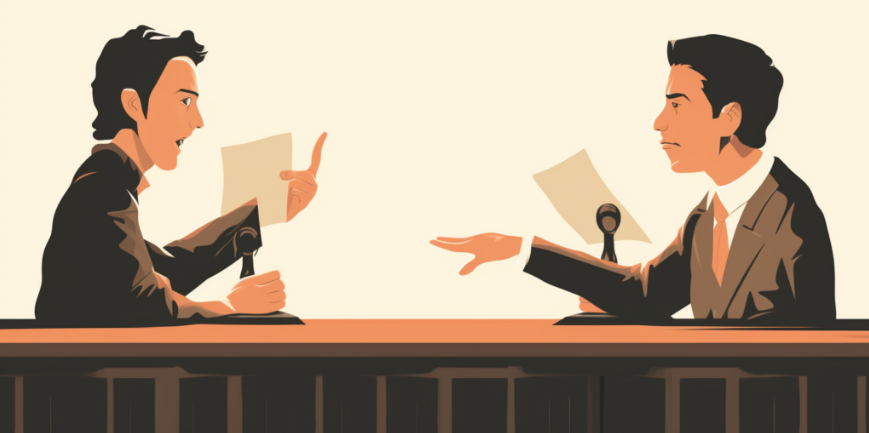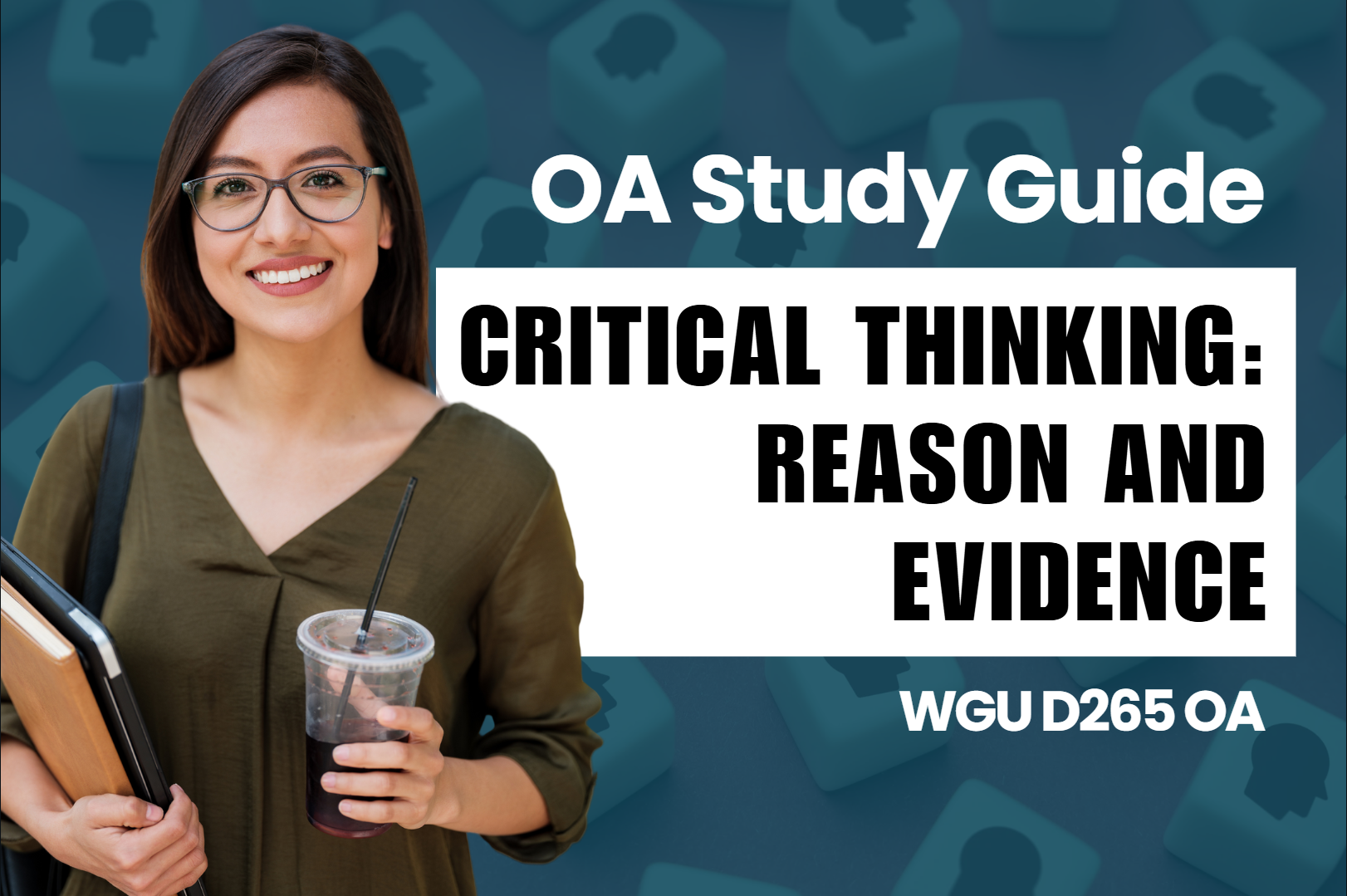WGU D265 OA Study Guide - 2025 | Mastering Critical Thinking📖
Sometimes it seems that your head wants to play tricks on you. Perhaps you passionately persuaded a discussion and then you come across your mind thinking your conclusion was not well substantiated well enough. Or perhaps you’ve found yourself sticking your head in the sand and denying what is right in front of your eyes. Don’t worry—you’re not alone! Even our brains act on some subconscious trends that make us view things askew. That’s why awareness of different fallacies and biases can really count here.
This article explores key concepts in critical thinking that affect reasoning and decision-making:
- Different Types of Fallacies: Fallacies are errors in reasoning that weaken arguments. Common types include ad hominem (attacking the person instead of the argument), straw man (misrepresenting an argument), and false cause (assuming correlation equals causation).
- Different Types of Biases: Biases are cognitive shortcuts that influence judgment. Examples include confirmation bias (favoring information that supports existing beliefs), anchoring bias (relying too much on initial information), and availability bias (basing decisions on readily available information).
Used before a debate, while doing research, or in an argument with a family member, friend, or partner, these tips will improve your critical analysis. Furthermore, for all of you who are lucky enough to study WGU D265, understanding these built politically pronounced concepts prepares you for those crafty WGU D265 OA questions that even geniuses cannot solve without confidence.
Let’s unravel the mysteries of fallacies and biases—and have a little fun while we’re at it!
How to Use This Guide for the WGU D265 OA Exam?📖
The D265 Critical Thinking Reason and Evidence OA exam at WGU evaluates your understanding of logical reasoning, argumentation skills, and evidence evaluation. This guide simplifies the key concepts of the different types of fallacies and the different types of biases to help you grasp the topics tested in the exam.
We also provide exam-style questions and practical applications to ensure you’re fully prepared for the questions on the WGU D265 OA exam

Understanding Different Types of Fallacies For D265 OA📝
Can you recall that time you read or heard what was a very sound line of reasoning but seemed somehow unsound when you really tried to think it through? That’s why at some point, the argument may have included a fallacy. This is an error of reasoning that vitiates an argument and by all appearances is logical. Most importantly, an understanding of the fallacies you are likely to come across in a debate situation, reading, or even in general conversations can prove very useful to you. In this section we will learn about some typical fallacies that take place, how it happened and we will serve examples to make the issue clear.
Formal Fallacies: Errors in Structure
Definition: Formal fallacies are mistakes in the structure or form of an argument. They occur when the conclusion doesn’t logically follow from the premises. These fallacies happen regardless of the argument’s content, meaning even if the premises are true, the conclusion might still be invalid.
Examples:
1. Affirming the Consequent:
- What it is: This fallacy holds that if a condition produces a given result, then the result must mean that the condition did occur.
- Argument: “If it rains, the ground will be wet. The ground is wet; therefore, it must have rained.”
- Why it’s wrong: It might not even have been the rain that made the ground wet, it could have been a sprinkler or some water that spilled. A domino effect doesn’t always mean that one factor is the root of the problem since one event can lead to another.
2. Denying the Antecedent:
- What it is: As we submit this paper, we shall witness that this fallacy assumes that if a condition does not happen, the result does not too.
- Argument: “If it rains, the ground will be wet. It didn’t rain; therefore, the ground isn’t wet.”
- Why it’s wrong: There could still be hose/dew for other reasons which make the ground to be wet. One thing is not exclusive of the other, the lack of one reason does not necessarily eliminate other reasons.
Thus formal fallacies are bridges that cannot support the connection between two phenomena, despite the fact that each of the segments looks rather solid.
Informal Fallacies: Errors in Content or Context
Definition: Informal fallacies arise from the content or context of an argument rather than its structure. These fallacies often rely on distractions, assumptions, or emotional appeals to mislead or persuade.
Ad Hominem (Attacking the Person)
- What it is: This fallacy occurs when someone attacks the person making an argument rather than addressing the argument itself.
- Example: “You can’t trust his opinion on climate change because he’s not a scientist.”
- Why it’s wrong: The truth or validity of an argument doesn’t depend on the personal characteristics of the person making it. Even if the person lacks expertise, their argument could still be valid if supported by evidence. Attacking the individual is a distraction from the actual argument.
Straw Man (Misrepresenting the Argument)
- What it is: This fallacy involves misrepresenting someone’s argument to make it easier to attack.
- Example: “People who want to regulate pollution just want to shut down all factories.”
- Why it’s wrong: I believe the basic intention of the argument may have been to enforce more rigid rules rather than closing factories. When the argument or value is exaggerated or distorted the real issue is avoided, thereby making it easier to contain the distorted value.
False Dilemma (False Dichotomy)
- What it is: This fallacy presents only two choices as if they are the only possibilities, ignoring other options.
- Example: “You’re either with us or against us.”
- Why it’s wrong: In reality there are always more sides or more options to solve the problem. This is one of the big weaknesses of arguing that way because by excluding the options you are making the situation black and white and forcing others to make decisions that are unfair.
Causal Fallacies: Mistakes About Cause and Effect
Definition: Causal fallacies are those having to do with an incorrect understanding of cause and effect. They frequently link events that do not really have much in common with each other.
Post Hoc Ergo Propter Hoc (False Cause)
- What it is: This fallacy assumes that because one event followed another, the first event caused the second.
- Example: “I wore my lucky socks, and we won the game; therefore, my socks caused the win.”
- Why it’s wrong: But what we found out later is the fact that correlation does not necessarily equal causation. Perhaps the win was not because of the socks and the teams they were representing but ‘the teams’ performance. Making a direct conclusion based on assumption creates wayward thinking.
Single Cause Fallacy
- What it is: This fallacy attributes an outcome to one cause when there are likely multiple contributing factors.
- Example: “The economy collapsed because of bad banking practices.”
- Why it’s wrong: Although faulty banking could have been the cause, there may be a policy, markets, or consumers to bias it as well. If matters are generalized, approaches are wrong or drawn to a wrong conclusion.
Ambiguity Fallacies: Confusing or Misleading Language
Definition: These fallacies involve the use of words and phrases that in one way or another make the argument look more forceful than it actually is.
Equivocation
- What it is: This fallacy occurs when a word with multiple meanings is used in different ways within the same argument.
- Example: “A feather is light; what is light cannot be dark; therefore, a feather cannot be dark.”
- Why it’s wrong: The word “light” is used with two different meanings—one refers to weight, and the other to brightness. This shift in meaning makes the argument invalid.
Slippery Slope
- What it is: This fallacy suggests that a small first step will inevitably lead to a chain of related events with significant consequences.
- Example: “If we allow students to redo their exams, soon they’ll expect to redo every assignment.”
- Why it’s wrong: There’s no evidence to support the idea that one action will automatically lead to the extreme scenario. Arguments like these often exaggerate the consequences to create fear or resistance.
Relevance Fallacies: Distracting from the Argument
Definition: Relevance fallacies introduce irrelevant information or appeal to emotions to divert attention from the main argument.
Red Herring
- What it is: This fallacy distracts from the argument by introducing unrelated topics.
- Example: “Why worry about climate change when there are so many homeless people?”
- Why it’s wrong: The two issues are separate and both deserve attention. Bringing up an unrelated issue shifts focus without addressing the original argument.
Appeal to Emotion
- What it is: This fallacy manipulates emotions instead of providing logical reasons.
- Example: “You should donate to this charity because look at these sad pictures.”
- Why it’s wrong: While emotions can be powerful, they don’t provide factual or logical support for the argument. Decisions should be based on reasoning and evidence, not just feelings.
Why Understanding Fallacies Matters For D265 OA
This is the essence of understanding fallacies – you always have a secret weapon in the way you think. Whenever you can identify the signs of improper reasoning taking place, then there is little chance of you being convinced by a bad argument. This skill is particularly critical for learners at WGU, and such a course as WGU D265 requires you to assess evidence and think logically. That is why learning to detect a fallacy is a solid ground for developing critical thinking high-quality analysis and decision-making.
At the end of this section, you should be able to distinguish between a correct and an incorrect way of thinking and approach different situations. That being said, let’s proceed to the next episodes on critical thinking with confidence and with an understanding of the hows!
Understanding Different Types of Biases For D265 OA📝
Imagine trying to make a fair decision, but your mind keeps leaning toward one option without you even realizing it. This is what biases do- they alter our way of thinking as well as our decision-making processes in ways that are hard to notice. A bias is a predisposed manner of interpreting information that results in routine errors when making decisions. In this part of the paper, different types of biases will be discussed with examples also the effect of the bias on the thinking process, and how the bias can be avoided.
Confirmation Bias: Seeing What We Want to See
Definition: Confirmation bias is the tendency to search for, interpret, and remember information that supports our pre-existing beliefs while ignoring evidence that contradicts them.
Example: A manager believes that a drop in sales is due to employees not working hard enough. They only focus on instances where employees were late but ignore data showing market changes caused the decline.
Why it happens: If it is more comfortable to go along with what we already think, our brains are quite agreeable to that idea. Disputing these beliefs may be disturbing, thus we tend to shun counterevidence.
Impact: Confirmation bias makes bad decisions because it narrows focus and leaves one blind to the bigger picture. For example, they may ban the possibility of a change in the company’s operations depending on the market environment since ESWMs are only interested in internal aspects of a company.
How to overcome it: Look for sources of information that present counterarguments, and facts that contradict your point of view. For example, you may start the battle with a question like “If I am wrong what is the best argument to give against me?”
Self-Serving Bias: Protecting Our Ego
Definition: Self-serving bias is the habit of attributing positive outcomes to our efforts and abilities while blaming negative outcomes on external factors.
Example: A student receives a high grade, and they have to do it on the basis of intelligence and hard work. However, when they get a low grade, they tend to argue that it was because the teacher came up with a bad grading policy.
Why it happens: This bias helps maintain self-esteem by protecting us from feeling responsible for failures.
Impact: As much as it can increase confidence, self-serving bias is also a way of constraining growth. If we constantly attribute our failures to external factors we are denying ourselves the chance to learn and grow.
How to overcome it: Properly evaluate what you have done right or wrong. The key question for every worker should be, “What could I have done differently?” and learning from one’s mistakes is encouraged.
Availability Heuristic: What Comes to Mind First
Definition: The availability heuristic is a mental stereotype where occurrences that come to the fore of a human mind are overemphasized greatly.
Example: Based on dramatic news clips related to aircraft accidents, a person may develop a bias that flying is actually a risky business when in fact, it is actually one of the safest ways of getting around on the planet.
Why it happens: People give more importance to recent and clearer events than they are real because they can easily be recalled.
Impact: This bias can skew our perception of risk and lead to irrational fears or decisions. For instance, avoiding flights but neglecting other, riskier behaviors.
How to overcome it: Look at data and facts rather than relying solely on memory. For example, research statistics about airplane safety instead of relying on dramatic news stories.
Group Bias (Herd Mentality): Following the Crowd
Definition: Group bias, or herd mentality, is the tendency to conform to the opinions or actions of a group, even when they may be irrational or wrong.
Example: During a stock market boom, many investors buy shares based on popular trends rather than thorough analysis. When the market crashes, those who follow the herd often face significant losses.
Why it happens: Humans are social creatures, and following the crowd feels safe. It’s easier to go along with others than to question them, especially in uncertain situations.
Impact: Group bias can suppress individual critical thinking and lead to poor decisions. It prioritizes consensus over careful evaluation of facts.
How to overcome it: Practice independent thinking. Before agreeing with a group decision, ask yourself, “Is this truly the best choice, or am I just following the crowd?”
Halo Effect: Judging a Book by Its Cover
Definition: The halo effect is a cognitive bias where our overall impression of someone influences how we perceive their other traits.
Example: A company hires someone who made a great first impression during the interview. They assume the candidate will excel at everything without objectively evaluating their skills.
Why it happens: Positive traits, like attractiveness or charm, create a “halo” that overshadows flaws. We’re wired to generalize based on first impressions.
Impact: The halo effect can lead to unfair advantages or disadvantages. For example, someone’s charm might overshadow their lack of qualifications.
How to overcome it: Focus on objective criteria. For instance, during interviews, use standardized evaluations to ensure decisions aren’t based solely on first impressions.
In-Group Bias: Favoring “Us” Over “Them”
Definition: In-group bias is the tendency to favor people who belong to the same group as us, whether it’s based on shared background, beliefs, or identity.
Example: A manager favors employees from their alma mater for promotions, assuming they’re inherently better performers than others.
Why it happens: We’re naturally inclined to trust and support those who are similar to us. It fosters a sense of belonging and loyalty.
Impact: This bias can lead to prejudice and unfair treatment of those outside the group, affecting workplace diversity and collaboration.
How to overcome it: Encourage diversity and inclusivity. Evaluate decisions based on merit rather than group membership. For example, use anonymous evaluation processes to reduce favoritism.
Why Understanding Biases Matters For D265 OA
Not everything one does depends upon their own choice; preferences control how one perceives objects and solves problems. It is crucial for students in the critical thinking course WGU D265, to understand the importance of the various biases to be able to overcome them in ways that will allow them to practice good reasoning and decision-making. By considering these biases, you will enhance the critical evaluation ability and enhance the ability to make reasonable choices on the topic considering easy real-life biases.
Having brought up the information about biases and how they work in thinking, you’ve got the necessary knowledge to doubt and think more consciously. As we progress through the work done as the art of critical thinking let us keep furthering on the skills above.
Tired of reading blog articles?
Let’s Watch Our Free WGU D265 Practice Questions Video Below!

Wrapping Up: Ace Your WGU D265 OA📄
Congratulations on diving into the world of fallacies and biases! If you haven’t already, you know how easily fallacies can worm their way into underhanded manipulation of logical processes and how biases can influence your cognition in relevant yet unobvious ways. You may think, it is not very realistic – no, these are the tools that help you enhance your critical thinking and become a better communicator.
As you prepare for the final WGU D265 OA, remember to practice spotting these fallacies and biases in everyday situations. Whether it’s a heated debate, a persuasive ad, or even your own reasoning, applying what you’ve learned will make these concepts second nature. Don’t forget—these topics will be tested in the OA, so grasping them now will not only help you pass but also enhance your reasoning skills for life.
Good luck on your journey through WGU D265, and may your critical thinking skills shine! You’ve got this!






